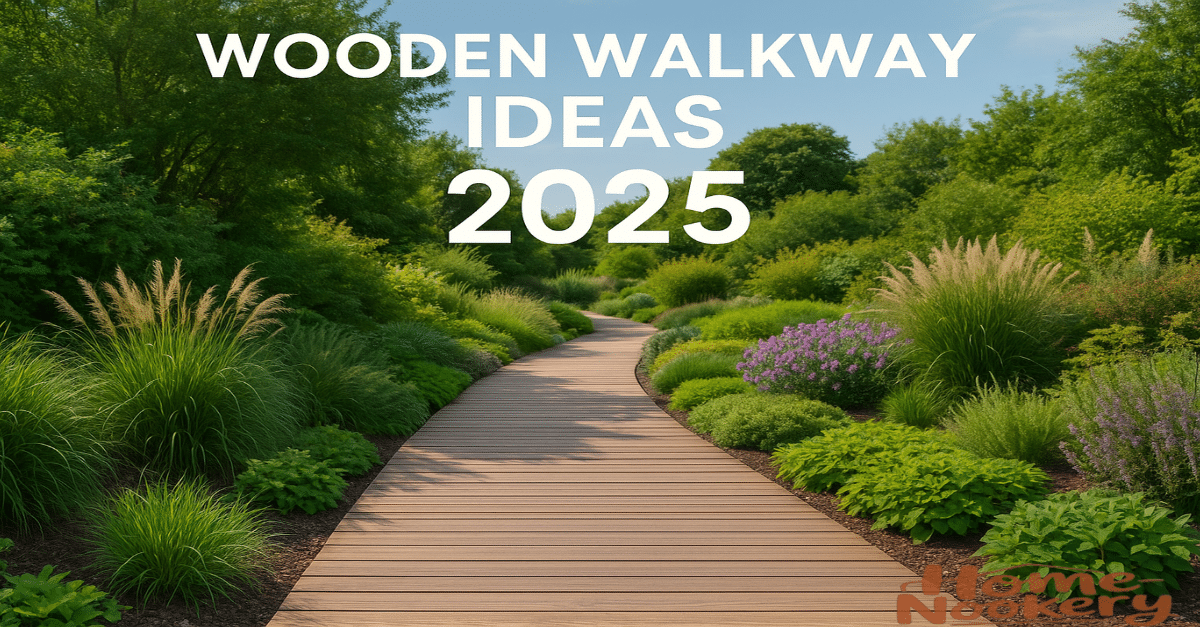There’s something timeless about the creak of wood beneath your feet. In 2025, wooden walkways are more than just paths—they’re sculptural statements that bring texture, warmth, and personality to your outdoor spaces. Whether you’re curving through tall grasses, crossing a tranquil pond, or making a bold entrance to your front door, wooden walkways blend nature with artistry like nothing else can.
Let’s explore 15 unique wooden walkway ideas for your garden, backyard, and outdoor spaces in 2025. Whether you’re dreaming up a DIY weekend project or planning a bold landscape feature, these ideas are designed to inspire.
15 Unique Wooden Walkway Ideas for Your Garden, Backyard, and Outdoor Spaces in 2025
1. Floating Zigzag Boardwalk
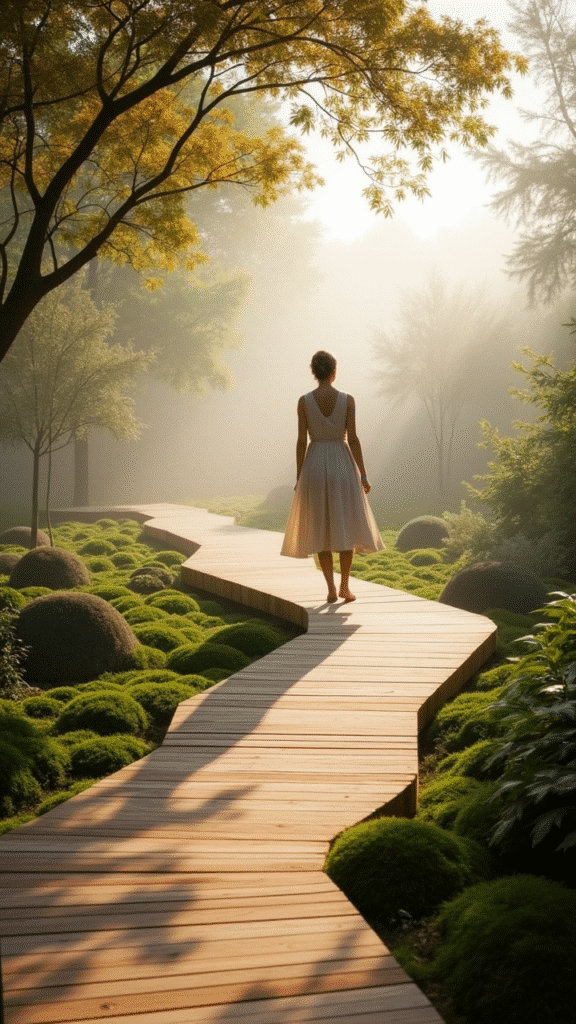
Imagine a wooden path that appears to hover just inches above a lush groundcover or shallow water feature. The floating zigzag boardwalk creates visual interest through its unexpected directional changes while maximizing the experience of traversing your garden. The key to this design is hidden structural support—steel posts anchored in concrete below grade that leave the walkway appearing to float magically above the landscape.
What makes this design particularly effective is the contrast between the geometric precision of the walkway and the natural chaos of plantings below. Choose low-maintenance sedges or mosses that can thrive in the dappled light beneath the boards. The zigzag pattern slows movement through the space, encouraging visitors to notice details they might otherwise miss.
2. Reclaimed Railway Tie Path
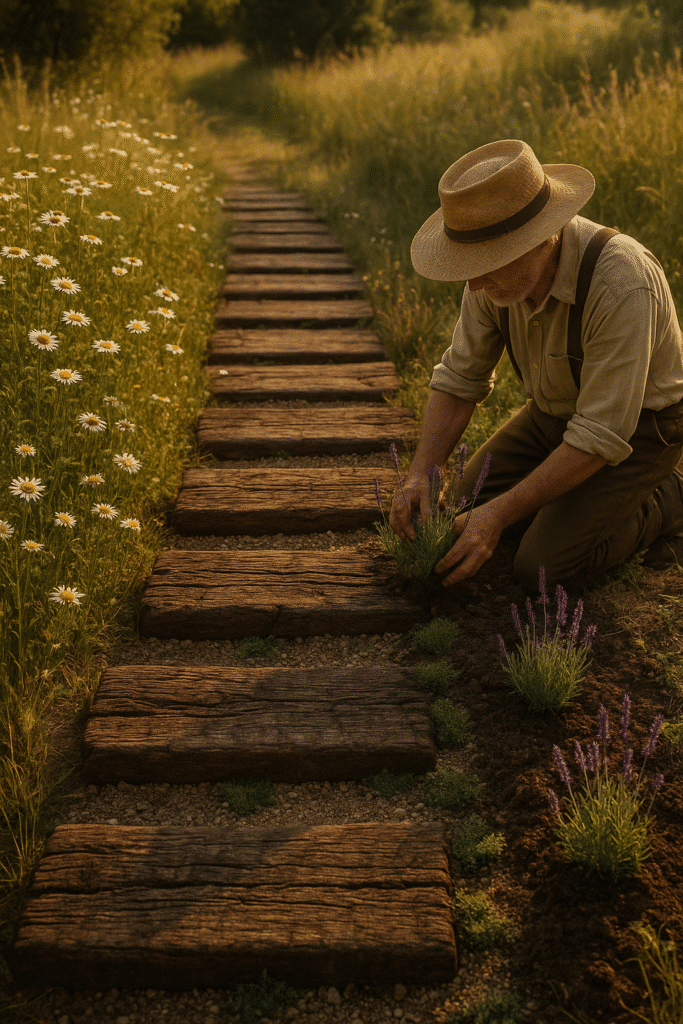
There’s something deeply satisfying about repurposing materials with history. Railway ties, with their massive proportions and weathered patina, make dramatic garden paths that feel as if they’ve been in place for generations. Due to concerns about creosote in older ties, look for newer alternatives or specially treated landscape timbers that mimic the look without the environmental concerns.
Installation is surprisingly straightforward—these hefty timbers can simply be laid onto a prepared base of crushed stone or sand. The gaps between ties can be filled with small gravel, crushed shells, or even planted with creeping thyme or other robust groundcovers that release fragrance when stepped upon. The irregular spacing and slight height variations between ties creates a rhythmic walking experience that naturally slows pace.
3. Backyard Boardwalk Retreat
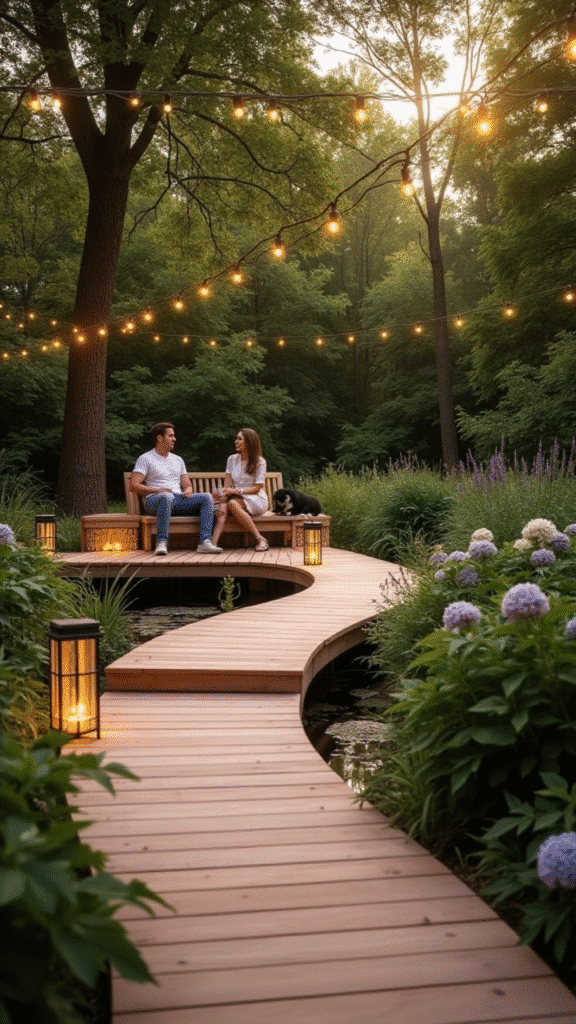
Transform your backyard into a personal escape with a wooden boardwalk that winds through your favorite landscaping elements. This design creates the feeling of a tranquil retreat right at home. Built with warm-toned hardwoods like teak or cedar, the walkway contrasts beautifully with surrounding ferns, hostas, or flowering shrubs.
Add wide platforms or occasional seating nooks along the path to turn your stroll into an immersive garden experience. Soft lighting tucked along the edges of the boardwalk enhances its retreat-like feel at night, inviting evening reflection or quiet conversation. Think of it as your personal forest path—even if you’re in the suburbs.
4. Woven Wood Platform Walk
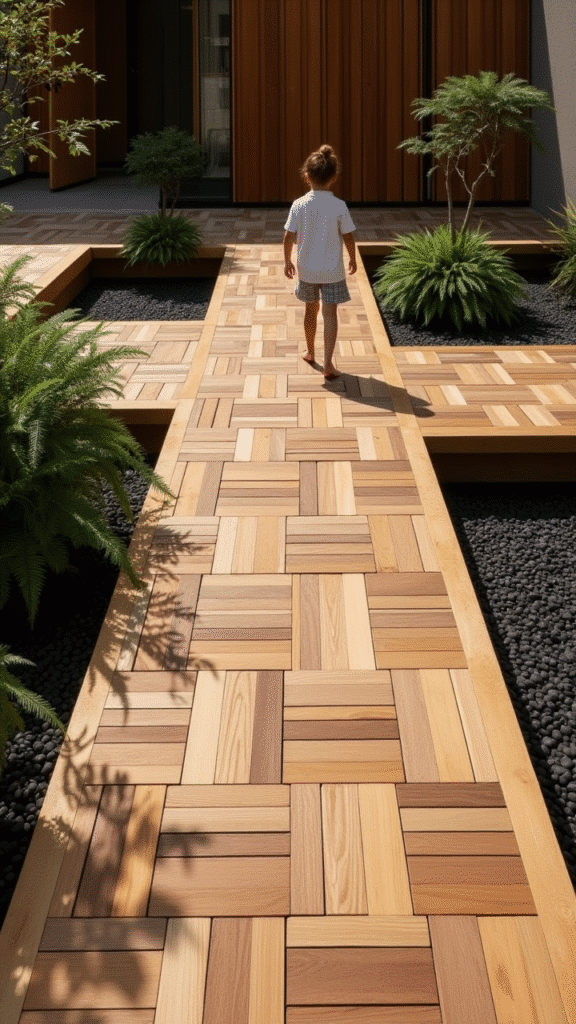
Drawing inspiration from traditional Japanese tatami mats, the woven wood platform walkway creates a stunning visual pattern through the alternating direction of boards. Thin strips of compatible woods—perhaps cedar and redwood, or oak and maple for more contrast—are arranged in a basket-weave pattern atop a sturdy frame. The result is both visually dynamic and texturally interesting underfoot.
This design works especially well for defined areas rather than long paths—perhaps a small meditation space or a transition zone between different garden rooms. The weaving pattern is inherently strong, distributing weight across multiple points rather than concentrating stress on individual boards. Consider treating different wood species with varying finishes to further enhance the pattern through subtle color variations.
5. Illuminated Night Path

Integrating lighting directly into your wooden walkway transforms it from a daytime functional element to a nighttime feature. Recessed LED fixtures can be installed between boards or along the edges, creating a gently illuminated path that enhances safety while adding drama. The latest low-voltage systems can be controlled via smartphone apps, allowing you to adjust brightness or even color throughout the evening.
What I find most compelling about illuminated wooden walkways is how they invert the typical experience of outdoor lighting. Rather than overhead fixtures casting shadows downward, the light emerges from below, highlighting textures and creating a sense of mystery. This approach is particularly effective for pathways that wind through densely planted areas, where the contrast between the lit path and dark plantings creates a cocoon-like sense of security.
6. Curved Boardwalk Through Wild Grasses
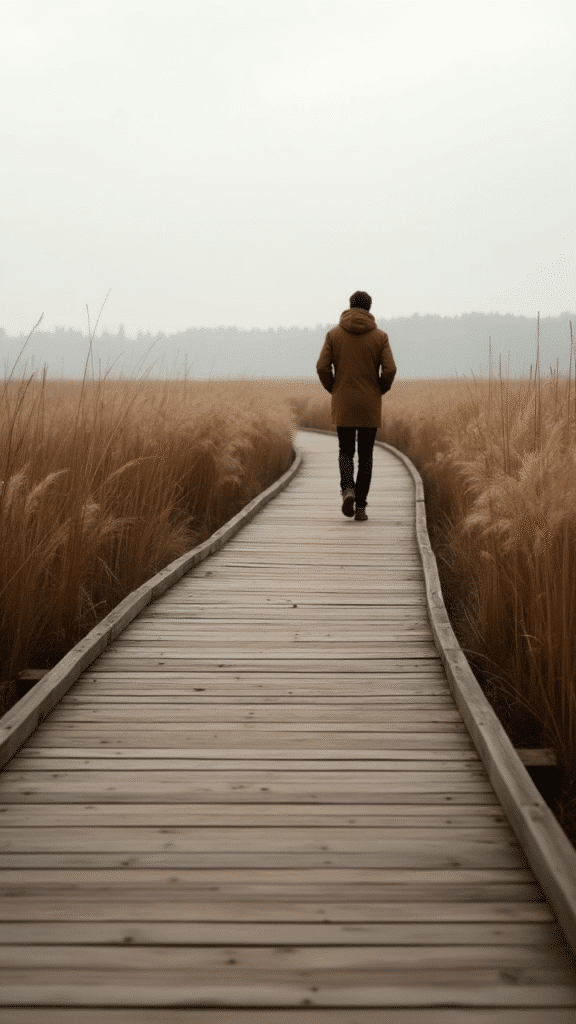
Straight paths serve efficiency; curved paths celebrate the journey. A gently curving boardwalk through a meadow-like planting of ornamental grasses creates a immersive experience that changes dramatically with the seasons. The key to this design is restraint in the curve—subtle bends that reveal new vistas gradually rather than sharp turns that feel contrived.
The interaction between rigid wood and flowing grasses creates a compelling contrast in both texture and movement. Select grasses that offer multiple seasons of interest, such as Miscanthus with its spectacular fall coloration or Panicum with delicate seed heads that persist through winter. Height is crucial here—the grasses should be tall enough to create a sense of enclosure without completely obscuring views beyond the immediate path.
7. Front Door Statement Boardwalk
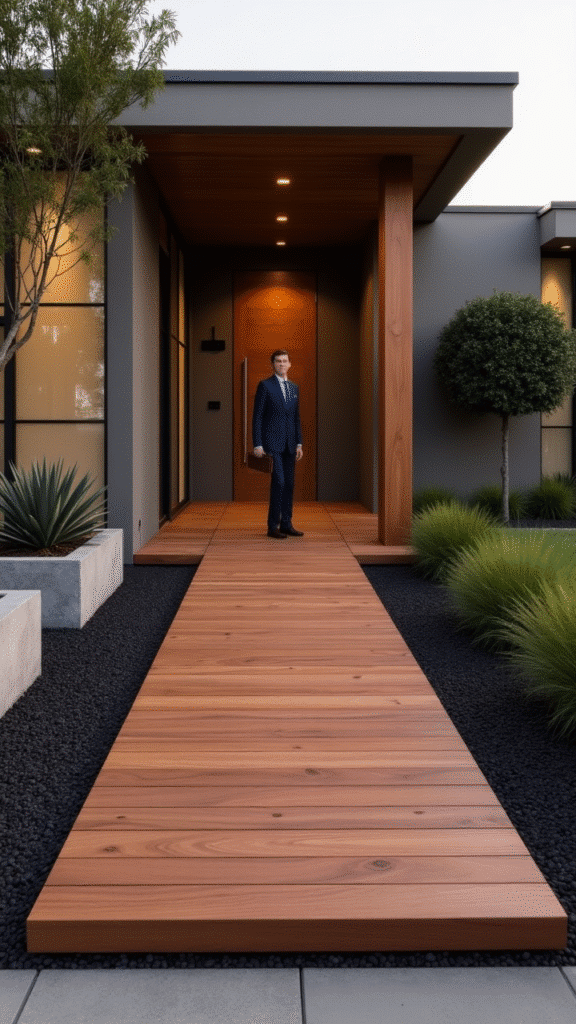
Why limit a boardwalk to the backyard? Make a dramatic first impression with a front walkway made of richly stained wooden planks arranged in clean, modern lines. Pair it with minimalist landscaping—like black river stones, boxwoods, and tall ornamental grasses—to keep the focus on the walkway’s warm texture and linear geometry.
Elevate the design with integrated planters or soft uplighting built into the edges. The use of horizontal wood leading up to your home instantly adds curb appeal while setting a tone of relaxed elegance. It’s not just an entry—it’s a design statement from the moment guests arrive.
8. Modular Wooden Stepping Pads
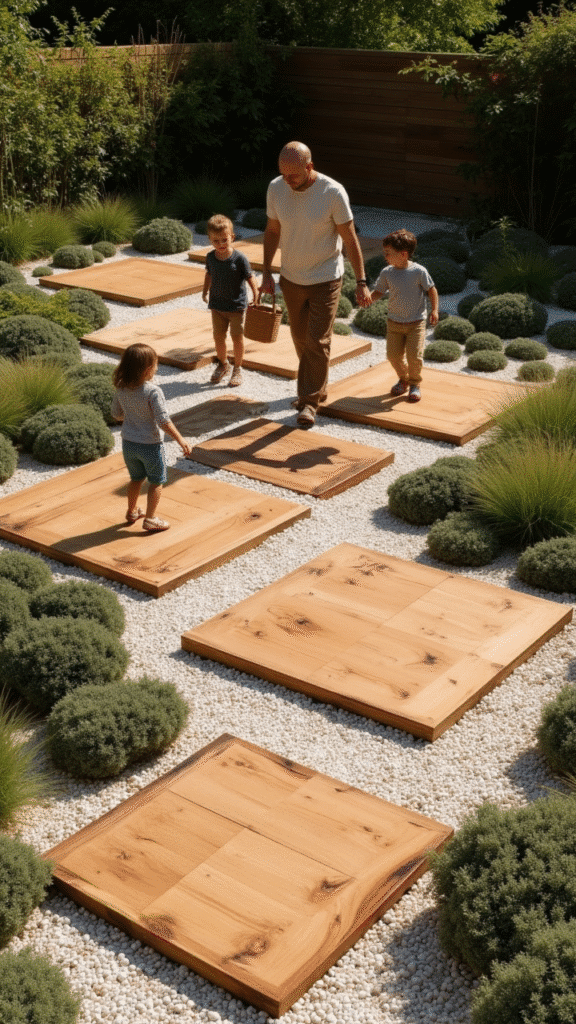
For spaces where flexibility matters, consider a pathway composed of individual wooden platforms rather than a continuous boardwalk. These modular elements—typically square or rectangular pads roughly 2-3 feet across—can be arranged in countless patterns and easily reconfigured as your garden evolves. The spaces between pads can be planted with low groundcovers, filled with decorative gravel, or even left as maintained lawn.
What makes this approach particularly appealing for 2025 is the opportunity for customization. Each pad becomes a potential canvas for personalization—perhaps different wood species, carved details, embedded objects, or even integrated tech like weather-resistant QR codes that link to information about nearby plants. The slight “hop” from pad to pad creates a playful walking experience that appeals to both children and the young at heart.
9. Boardwalk with Integrated Seating
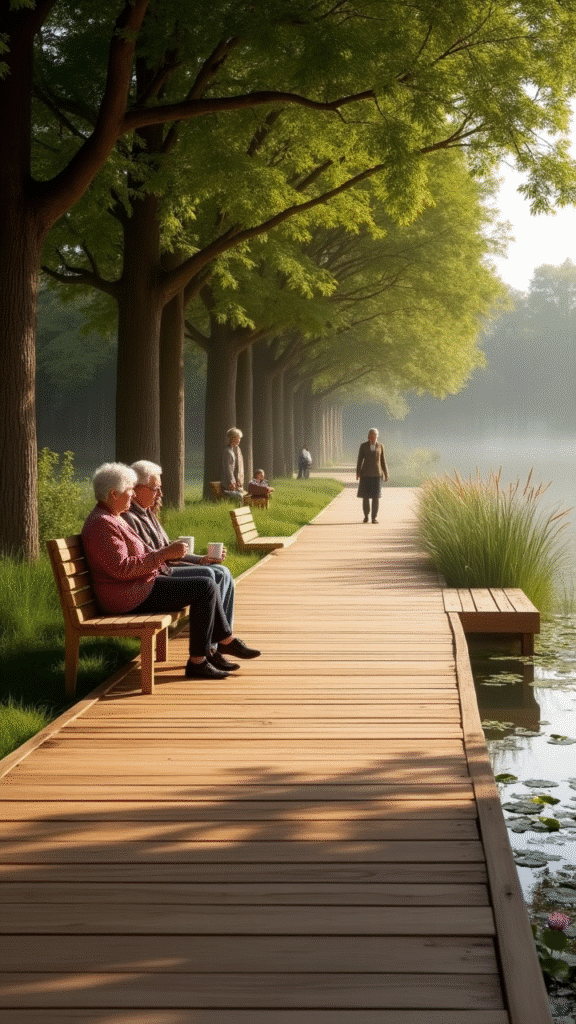
Why should a path merely connect destinations when it can become a destination itself? By widening sections of your wooden walkway and incorporating built-in benches, you transform a transitional space into a place for pause and reflection. These integrated seating areas feel more organic and intentional than furniture simply placed alongside a path.
The most successful designs maintain visual continuity by using the same materials and construction methods for both the path and seating elements. Consider how the seating might frame particular views or create opportunities for different social configurations—perhaps a single bench for solitary contemplation in one area and facing benches for conversation in another. Subtle shifts in the height of the walkway can naturally define these seating zones without the need for additional railings or visual barriers.
10. Wooden Walkway Over Water Feature
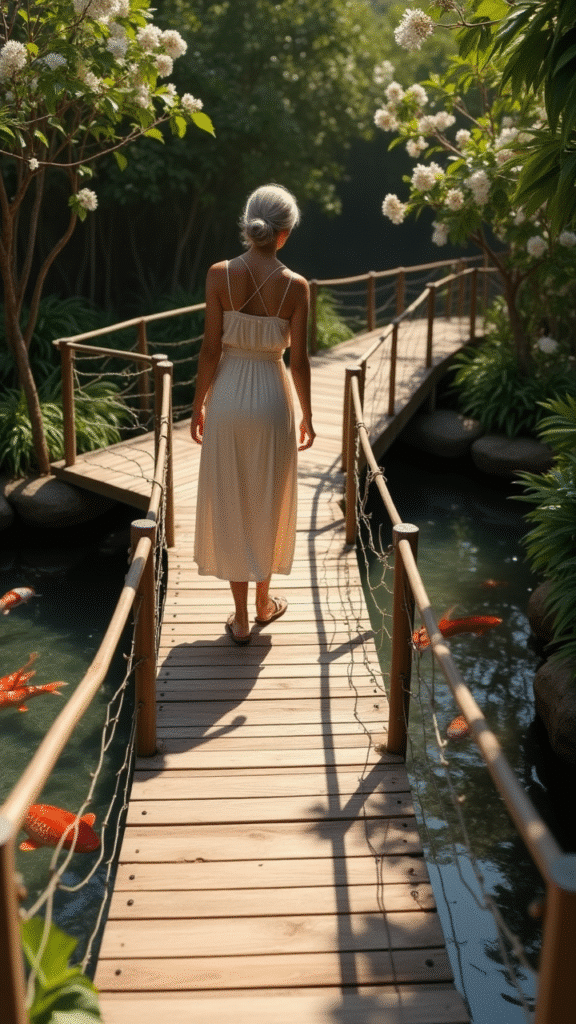
Few design elements create as much drama as a wooden walkway that crosses directly over water. Whether spanning a natural pond, a constructed water garden, or even a dry creek bed that occasionally fills with rainwater, these pathways create moments of transition that engage multiple senses—the sound of water below, the slight bounce of boards underfoot, the visual play of reflections.
Safety and durability obviously become paramount when combining wood and water. Consider using marine-grade construction methods, including stainless steel fasteners and water-resistant wood species like cedar, redwood, or tropical hardwoods. The gaps between boards become especially important here, allowing for drainage while providing glimpses of the water below. Adding subtle railings or edge details enhances both safety and the sense of being suspended above the water.
11. Wooden Pathway with Living Roof
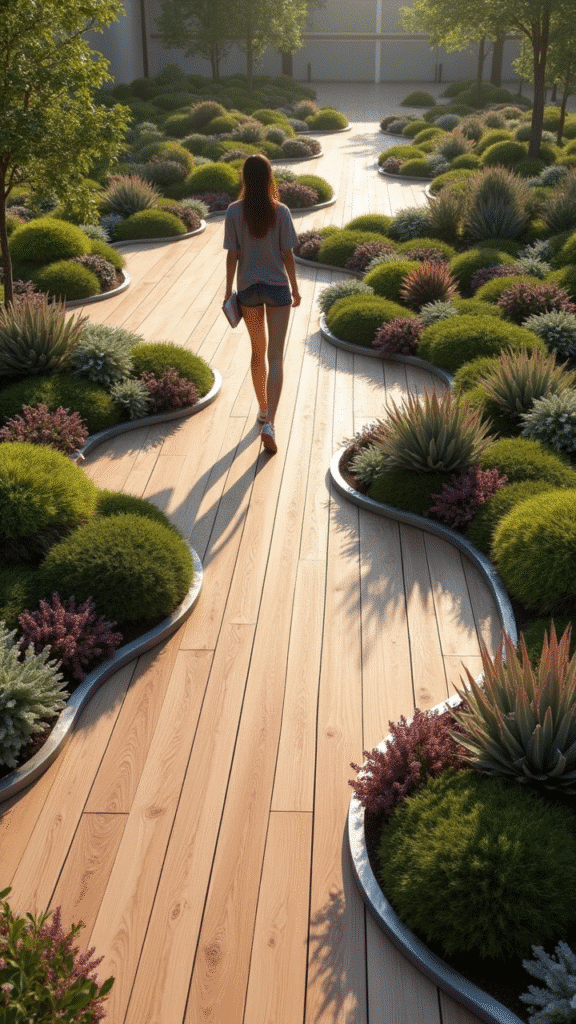
Combining a wooden walkway with elements of green roof technology creates a truly innovative garden feature. Imagine sections of your pathway covered with low-growing sedums, sempervivums, or other shallow-rooted plants, creating the impression of a living carpet suspended above the ground. These planted sections can alternate with traditional wooden decking, creating rhythm and visual interest.
The technical challenges are significant but solvable—waterproof membranes protect the structural wood from moisture, while lightweight growing media supports appropriate plant selections. Proper drainage is essential, as is selecting plant species that can thrive in the specific light conditions of your walkway. What makes this approach particularly appealing is how it blurs the line between architecture and landscape, creating spaces that feel simultaneously designed and natural.
12. Pallet Wood Herringbone Path
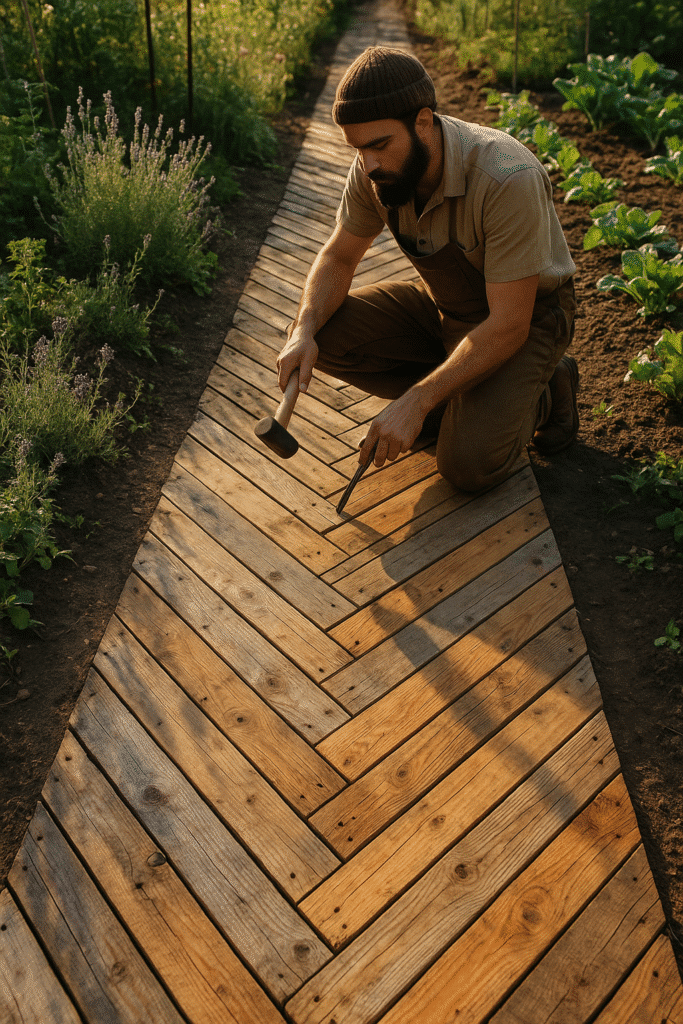
Sustainability meets style in walkways constructed from reclaimed pallet wood arranged in elegant herringbone patterns. The varied coloration and weathering of pallet boards creates rich visual texture, while the herringbone arrangement provides exceptional structural stability for a walking surface. This approach transforms humble materials into a sophisticated design statement.
The key to success with pallet wood is careful selection and preparation. Look for heat-treated pallets (stamped with “HT”) rather than chemically treated ones, and spend time removing all nails and thoroughly cleaning the wood before construction. The irregular dimensions of pallet boards actually become an advantage in herringbone patterns, where slight variations create charming imperfections that would be costly to deliberately engineer with new materials.
13. Wooden Walkway with Integrated Planter Boxes
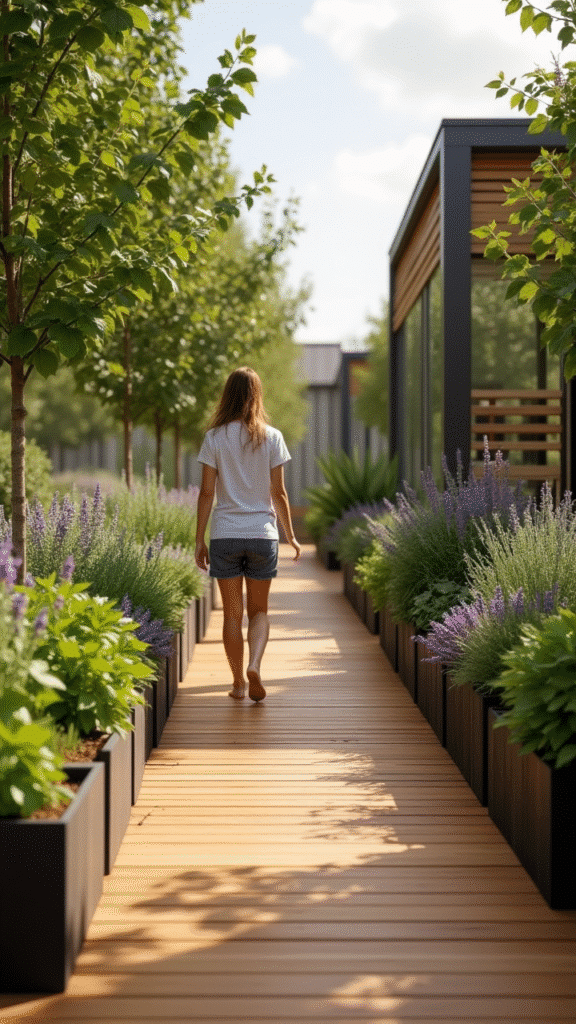
Blur the boundary between path and garden by incorporating planter boxes directly into your wooden walkway design. These integrated growing spaces can frame the path with seasonal color, herbs for brushing against while walking, or even edible plantings that make harvesting a natural part of moving through the garden. The slight elevation change between walkway and planting areas creates natural definition without visual barriers.
For maximum impact, consider how plantings might interact with those walking the path—perhaps lavender that releases fragrance when brushed against, or strawberries that can be harvested without bending down. The proximity of wood to soil requires careful construction details to prevent premature rot, including adequate drainage, barriers between soil and structural elements, and appropriate selection of rot-resistant wood species.
14. Musical Wooden Walkway
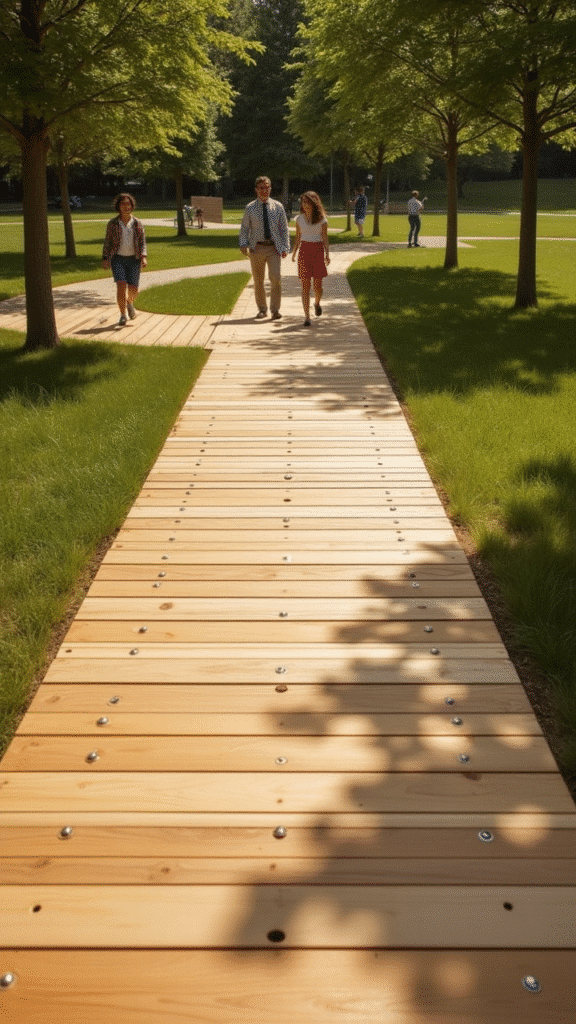
Engage another sense entirely with a wooden walkway designed to create sound. By carefully engineering sections with different resonant qualities—achieved through varying the thickness of boards, the spacing between them, and the structural support below—you can create paths that respond to footsteps with subtle musical tones. These can be random and naturalistic or carefully tuned to produce specific notes when walked upon at normal pace.
This playful approach works particularly well in family gardens or public spaces where unexpected delight enhances the experience. The technical aspects require experimentation, but even simple variations in board thickness can produce noticeable differences in acoustic response. Consider how weather conditions might affect your musical pathway—damp boards will produce different tones than dry ones, potentially creating seasonal variations in your garden’s soundtrack.
15. Puzzle-Piece Wooden Platform
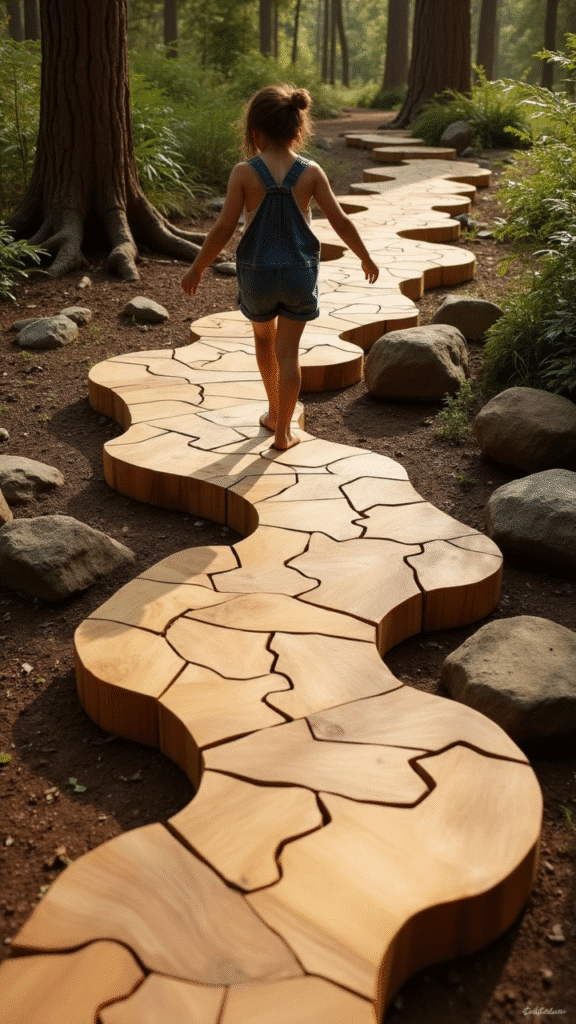
For areas where a traditional linear walkway feels too conventional, consider a pathway composed of interlocking wooden sections in organic shapes. These puzzle-like pieces create a playful walking experience while allowing for integration with existing landscape features. The irregular edges blur the boundary between path and surroundings, creating a more integrated feel than straight-edged boardwalks.
The construction challenge lies in creating stable connections between irregularly shaped sections while maintaining adequate structural support. Concealed metal brackets or below-grade connection systems can maintain the organic aesthetic above ground. This approach works particularly well in naturalistic garden settings where geometric paths would feel out of place, or in play-focused landscapes where the unconventional forms encourage exploration.
Final Words
The wooden walkway renaissance of 2025 celebrates this ancient material in ways both innovative and timeless. Whether you’re drawn to the technical sophistication of integrated technology or the rustic charm of reclaimed materials, there’s a wooden pathway concept perfectly suited to your outdoor space. What connects all these ideas is their embrace of wood’s inherent warmth, character, and connection to the natural world.
As you consider which approach might work for your garden, remember that the most successful pathways aren’t just about moving through a space—they’re about experiencing it more fully. A thoughtfully designed wooden walkway doesn’t just change how you move through your garden; it transforms how you see it, feel it, and connect with it. In that way, these humble wooden structures become something far greater than the sum of their boards and fasteners—they become the thread that ties your outdoor experience together.
Your perfect wooden walkway awaits, ready to transform your ordinary garden into an extraordinary journey. The only question is: which path will you choose to create?

Mariana is the founder and voice behind Home Nookery, a curated blog dedicated to home design, décor inspiration, and cozy living. With a passion for creating beautiful, functional spaces, Mariana shares practical tips, styling ideas, and thoughtful insights to help readers turn their houses into homes. Whether you’re redesigning a room or just adding a touch of charm, she’s here to guide you with creativity and heart.
